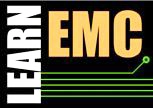EMC Question of the Week: September 29, 2025

A good rule of thumb for ensuring that the crosstalk between microstrip traces is -20 dB or lower is to maintain a spacing between the traces that is at least three times the trace
- width
- length
- height
- thickness
Answer
The best answer is “c.” If the spacing between microstrip traces is at least three times the trace height (i.e. height above the plane), the worst-case crosstalk is generally -20 dB or lower. This is because the electric and magnetic field strengths start dropping off rapidly once the distance from the trace edge exceeds the trace height. This is illustrated by the plots of the current density beneath microstrip traces with different widths in the figure below. The fields near the plane surface are proportional to the current density. Note that the density falls off with distance from the trace edge at nearly the same rate independent of the trace width.
For typical circuit board geometries, the width and thickness of the traces have relatively little effect on the crosstalk. In fact, formulas for approximating the crosstalk between microstrip traces often express the crosstalk as being proportional to where s is the spacing and h is the trace height. This is much simpler than the expression with inverse tangents in the figure, and it is reasonably accurate even though it ignores the trace width and thickness.
The length of the traces is important at frequencies where the trace is shorter than a quarter wavelength. At these frequencies, the crosstalk is proportional to the length. However, in most cases, it would not be reasonable or desirable to require the spacing to be three times the trace length.
And yes, we're aware of the infamous 3W rule (i.e. that the spacing should be three times the trace width). From a technical standpoint, this rule is misleading, because it suggests the trace width plays an important role in the crosstalk. 3H is a much better guideline. Nevertheless, for high-speed signals, the trace widths are often approximately equal to the trace height or a little wider. In these cases, applying a 3W rule is sufficient to meet the 3H criteria.

Have a comment or question regarding this solution? We'd like to hear from you. Email us at
